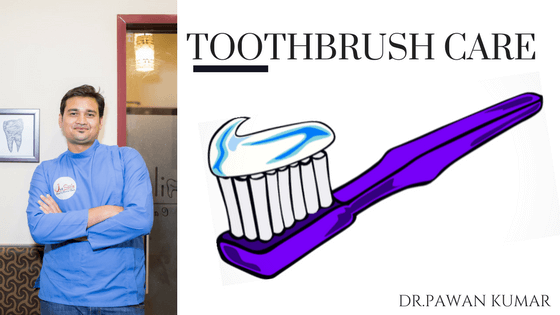
Tooth Brush Care
Tooth Brush Care
Keep Your Teeth Clean and The Toothbrush Cleaner
The use of a toothbrush has become a part of our daily routine. The regular use of toothbrush helps promote oral health and enables effective removal of plaque which in turn, helps to prevent periodontal disease.
A Toothbrush- We know all about it; We use it daily; But do we really know how clean the toothbrush that we use to clean our teeth is?
The use of a toothbrush has become a part of our daily routine. The regular use of toothbrush helps promote oral health and enables effective removal of plaque which in turn, helps to prevent periodontal disease.
However, these toothbrushes can also become contaminated with microorganisms and the survival of micro-organisms on a toothbrush can lead to recontamination of the mouth.
Contamination of a toothbrush is seen right from its initial use and increases with repeated use. A Toothbrush also gets contaminated with microorganisms present in the environment. It may also be possible for microorganisms that are present in the environment where the toothbrush is stored to establish themselves on the brush.
Hence, there is an utmost need for standardized, guidelines to keep a toothbrush clean and hygienic.
Toothbrush care
Design
It has been proven that bacteria get trapped inside the bristles of a toothbrush and the level of growth depends upon the type of bacteria and the design of a toothbrush. Frayed and closely placed bristles to 0trap and retain more bacteria.
Also, retention of moisture and oral debris in the bristles increases the growth of bacteria. Bacterial contamination is found to be low in a toothbrush with soft and round bristles than the one with hard plastic bristles.
Decontamination
A toothbrush can become heavily contaminated soon after the use. A number of studies have shown that immediately after brushing, a toothbrush harbours a significant number of microorganisms.
Contamination of a toothbrush may lead to colonization of bacteria and could result in infection. Design, colour, opacity and bristle arrangement of a toothbrush are a major contributing factor in retaining microorganisms.
Hence, a toothbrush should be disinfected at regular intervals to help prevent infection of the mouth.
There are a number of decontamination techniques. Toothpaste, Mouthwash and Oral Antiseptics all decrease the microbial load on a toothbrush. The decontamination method of a toothbrush should be effective and easy to implement.
Some of them are:
- Soaking a toothbrush in Listerine for 20 minutes prior to and after brushing decreases microbial load.
- Use of Toothpaste also reduces bacterial growth on a toothbrush.
- Overnight immersion of a Toothbrush in Chlorhexidine mouthwash is also highly effective in decreasing contamination of a toothbrush. Chlorhexidine is found to be more effective than Listerine in reducing microbial load.
- Vinegar, among household materials, is a good decontaminant, followed by Lime and Saltwater.
- 1% Sodium Hypochlorite is an effective compound for disinfection of a toothbrush.
Storage
- Use of a cap for a toothbrush increases bacterial survival.
- A toothbrush kept in closed containers results in higher bacterial growth than one exposed to air.
- A toothbrush exposed to a contaminated surface also results in higher bacterial growth.

Replacement
- American Dental Association, in 1996, recommended replacing a toothbrush after every 3 months.
- Patients undergoing Chemotherapy should replace their toothbrush after every 3 days.
- Patients subject to major surgery should replace the toothbrush every day.
Do’s
- A toothbrush should be stored in an upright position if possible and allowed air dry.
- A toothbrush should be disinfected at intervals. Although studies have shown that various microorganisms can grow on a toothbrush with repeated use, the evidence is lacking that bacterial growth on a toothbrush leads to health problems. However, cleaning the oral cavity with a contaminated toothbrush will do more harm than good. Thus, it is essential to disinfect a toothbrush at regular intervals for preventing reinfection of the oral cavity.
Don’ts
- Never store a toothbrush in containers as the number of bacteria on a toothbrush stored in an open air, after use decreases more quickly than the one kept in containers.
- Rinsing a toothbrush with tap water results in a continued higher level of contamination and biofilm formation.
- A toothbrush should not be kept covered.
- A toothbrush should not be kept in a bathroom, especially the one combined with a toilet, as this harbours a potential amount of pathogens.
- A number of toothbrushes should not be kept in one container as they rub against one another and result in cross-contamination.
- A toothbrush should not be shared among individuals.
Keeping a toothbrush clean and regularly changing it is an important part of maintaining a healthy mouth.
If you need more details or information, you can visit Dr.Pawan at
Ramchandra’s Jussmile Dental Clinic,
1333/A,B1,Royal Castle Apartments,
7th cross street,
Poompuhar Nagar,Kolathur,
Chennai-99
To fix an appointment online – Click Here
You can also reach them through phone +91 9884336617 / +91 44 42802255, or email at info@jussmile.com
To help patients, Jussmile Dental Clinic has partnered with leading finance companies to provide easy finance for dental treatments. This service is designed to help pay for all your dental procedures, whether root canal treatment or Dental Implants, with minimal documentation and time. Finance is available, which can be repaid at your ease by opting for tenures ranging from 6-12 months. *Please understand that the final decision is at the sole discretion of finance company. 0% interest is also available with credit card holders, but terms & conditions vary depending on the credit card service providers.


Leave a Reply